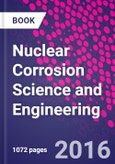Corrosion of nuclear materials, i.e. the interaction between these materials and their environments, is a major issue for plant safety as well as for operation and economic competitiveness. Understanding these corrosion mechanisms, the systems and materials they affect, and the methods to accurately measure their incidence is of critical importance to the nuclear industry. Combining assessment techniques and analytical models into this understanding allows operators to predict the service life of corrosion-affected nuclear plant materials, and to apply the most appropriate maintenance and mitigation options to ensure safe long term operation.
This book critically reviews the fundamental corrosion mechanisms that affect nuclear power plants and facilities. Initial sections introduce the complex field of nuclear corrosion science, with detailed chapters on the different types of both aqueous and non aqueous corrosion mechanisms and the nuclear materials susceptible to attack from them. This is complemented by reviews of monitoring and control methodologies, as well as modelling and lifetime prediction approaches. Given that corrosion is an applied science, the final sections review corrosion issues across the range of current and next-generation nuclear reactors, and across such nuclear applications as fuel reprocessing facilities, radioactive waste storage and geological disposal systems.
With its distinguished editor and international team of expert contributors, Nuclear corrosion science and engineering is an invaluable reference for nuclear metallurgists, materials scientists and engineers, as well as nuclear facility operators, regulators and consultants, and researchers and academics in this field.
- Comprehensively reviews the fundamental corrosion mechanisms that affect nuclear power plants and facilities
- Chapters assess different types of both aqueous and non aqueous corrosion mechanisms and the nuclear materials susceptible to attack from them
- Considers monitoring and control methodologies, as well as modelling and lifetime prediction approaches
This book critically reviews the fundamental corrosion mechanisms that affect nuclear power plants and facilities. Initial sections introduce the complex field of nuclear corrosion science, with detailed chapters on the different types of both aqueous and non aqueous corrosion mechanisms and the nuclear materials susceptible to attack from them. This is complemented by reviews of monitoring and control methodologies, as well as modelling and lifetime prediction approaches. Given that corrosion is an applied science, the final sections review corrosion issues across the range of current and next-generation nuclear reactors, and across such nuclear applications as fuel reprocessing facilities, radioactive waste storage and geological disposal systems.
With its distinguished editor and international team of expert contributors, Nuclear corrosion science and engineering is an invaluable reference for nuclear metallurgists, materials scientists and engineers, as well as nuclear facility operators, regulators and consultants, and researchers and academics in this field.
- Comprehensively reviews the fundamental corrosion mechanisms that affect nuclear power plants and facilities
- Chapters assess different types of both aqueous and non aqueous corrosion mechanisms and the nuclear materials susceptible to attack from them
- Considers monitoring and control methodologies, as well as modelling and lifetime prediction approaches
Table of Contents
Part 1 Introduction to corrosion in nuclear power applications: Overview of corrosion engineering, science and technologyOverview of nuclear materials and nuclear corrosion science and engineering
Understanding and mitigating corrosion in nuclear reactor systems. Part 2 Aqueous corrosion in nuclear power applications: Fundamental science, materials and mechanisms: General corrosion in nuclear reactor components and nuclear waste disposal systems
Environmentally assisted cracking (EAC) in nuclear reactor systems and components
Irradiation assisted corrosion and stress corrosion cracking (IAC/IASCC) in nuclear reactor systems and components
Flow assisted corrosion (FAC) in nuclear power plant components
Microbiologically influenced corrosion (MIC) in nuclear power plant systems and components. Part 3 Non-aqueous corrosion in nuclear power applications: Fundamental science, materials and mechanisms: High-temperature oxidation in nuclear reactor systems
Liquid metal corrosion in nuclear reactor and accelerator driven systems. Part 4 Corrosion monitoring and control in nuclear power applications: Electrochemical techniques for monitoring and controlling corrosion in water-cooled nuclear reactor systems
On line electrochemical monitoring in light water nuclear reactor (LWR) systems
Modelling corrosion in nuclear power plant systems
Lifetime prediction techniques for nuclear power plant systems. Part 5 Corrosion issues in current nuclear reactors and applications: Corrosion issues in pressurized water reactor (PWR) systems
Intergranular stress corrosion cracking (IGSCC) in boiling water reactors
Corrosion issues in pressurised heavy water reactor (PHWR/CANDU) systems
Corrosion issues in water-cooled water-moderated energetic reactor (WWER) systems
Corrosion issues in nuclear fuel reprocessing plants. Part 6 Corrosion issues in next generation nuclear reactors and advanced applications: Corrosion issues in high temperature gas cooled reactor (HTR) systems
Corrosion issues in sodium-cooled fast reactor (SFR) systems
Corrosion issues in lead-cooled fast reactor (LFR) and accelerator driven systems (ADS)
Corrosion issues in molten salt reactor (MSR) systems
Corrosion issues in supercritical water reactor (SCWR) systems
Corrosion issues in thermonuclear fusion reactors and facilities
Corrosion issues of radioactive waste packages in geological disposal systems.
Authors
Feron, DamienDr. Damien Feron is Director of Research at the Nuclear Energy Division of the Atomic Energy and Alternative Energies Commission (CEA) and Professor at the National Institute for Nuclear Science and Technology (INSTN), France. He is also Chairman of the Nuclear Corrosion Working Party (WP4) and of the Science and Technology Advisory Committee (STAC) of the European Federation of Corrosion (EFC). He is world-renowned for his leadership and research in the field of nuclear materials corrosion and its mitigation.








